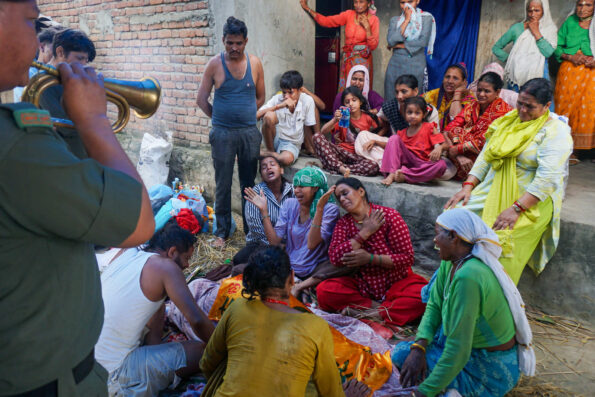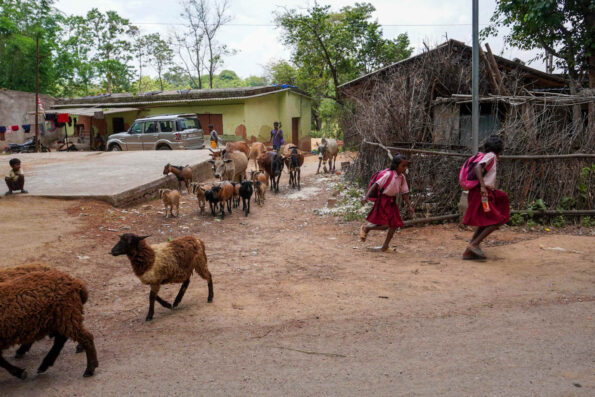
Priscila Hernández, GPJ Mexico
Juana Reyna, who is Nahua, poses for a portrait at Encuentro de Lenguas Maternas, the craft fair where she sells her craftwork.
GUADALAJARA, MEXICO — Juana Reyna points out sunspots on her cheeks, scars from selling her artisan wares on the streets of Guadalajara. During the coronavirus pandemic, she survived by walking among vehicles in traffic. “I sold embroidered face masks,” she says. “I would be sweating, selling on the corners.” The relentless sun, day after day, scorched her skin.
Street vending in Mexico is dangerous and difficult. Artisans often wander the streets to find a spot to sell their products. Next to the filth of the street and foul-smelling sewers, contending with the sun, the cold and the rain, they sit on sidewalks, vulnerable to passersby stepping on and destroying their work, dogs urinating on their blankets and people spitting nearby. Potential customers loom over them, creating an unequal distribution of power as they haggle and attempt to pay little for a piece of craftwork that in some cases can take an entire day of labor. As it is the only sort of income for many Mexican artisans, restrictions on street vending can throw their livelihoods into jeopardy. Juana Reyna, who asked to always be identified by her full name, worked this way for 30 years, from the age of 12. But now, she tells her story in the shade of a white awning at a craft fair.
Along with four other indigenous craftswomen, Angélica García founded Mujeres raíces de la ZMG, a collective that helps artisans like Juana Reyna have access to craft fairs and turn street vending restrictions in Guadalajara into an opportunity. Craft fairs put artisans on equal footing with their customers and allow them to sell with dignity and earn a better living in safer and healthier conditions.
More than 20 artisans interviewed by Global Press Journal say that what matters most to them is that the efforts of Mujeres raíces have reinstated dignity to their craft.
“When you’re on the floor, clients make you feel inferior,” García says. But at craft fairs artisans feel more respected. “You have the opportunity to showcase your culture.”



On a craft fair table, Juana Reyna arranges hand-painted clay figures of owls, cats and hummingbirds, decorated with flowers reminiscent of those in Ameyaltepec, her hometown. The yellows, blues, pinks and blacks contrast with the white tablecloth. She no longer fears that someone will step on her work.
According to the most recent data available from Data México, an official government website, the street vendor workforce stood at 1.63 million people nationwide. Of that total, 56.1% were women. Street vending represents nearly 3% of the total employed workforce in Mexico, and in Jalisco, where Guadalajara is located, there was an increase of 27,700 street vendors, or 41%, between 2021 and 2023.
In 2017, Guadalajara instituted the latest restrictions on street vending in the historic city center. They limit where vendors can sell and subject them to merchandise confiscation and fines, which range as high as 5,600 Mexican pesos (approximately 304 United States dollars), if vendors sell in restricted areas. With an average income of 3,890 pesos (approximately 211 dollars) per month, according to Data México, for street vendors, these fines can be impossible to pay, and they opt for their merchandise to be confiscated. Inspectors confiscated Juana Reyna’s handicrafts seven times when she was street vending, and she was unable to get them back, she says.
Juana Reyna came to Guadalajara when she was 8 years old, the same age at which her father taught her to paint clay. Now, she no longer looks around, anxious, to see if municipal inspectors are coming. “I’m happy,” she says, seated comfortably in a chair. “So happy!”



Encuentro de Lenguas Maternas, the fair where Juana Reyna and other Mujeres raíces artisans sell their crafts, was orchestrated by Norma Joela Acevedo Olea, director of Dirección de Pueblos Originarios del Gobierno de Guadalajara, a department in charge of the protection, promotion and defense of indigenous rights in the city.
“It’s a more dignified way to exhibit their work,” Acevedo Olea says. “[It improves] quality of life because being in the streets is exposing oneself to many troublesome situations, to the sun, to insecurity.”
Juan Francisco Ramírez Salcido, acting mayor of Guadalajara, says the restrictions on street vending seek to encourage “spaces like this one, where artisans can introduce people to their gastronomic and artisanal culture,” referring to craft fairs. He adds that he is open to “allowing for [group] orderly itinerant trade.” But he cautions that, individually, “no one can get permission” for street vending in the historic city center, as some artisans want. Spots in fairs are limited and not all artisans secure one.
Today, Mujeres raíces is home to 45 craftswomen, who hail from the Wixárika, Purépecha, Nahua, Otomí and Mixteco indigenous groups. Most of them were at the Encuentro de Lenguas Maternas craft fair. “The need to work, to show what we do, it’s uniting us the most,” says García, who comes from a family of artisans who sold on the streets for generations. “These spaces help people get to know our crafts.”
Reversing adversity
When she sold necklaces on the street, Esperanza Acevedo, who is Mixtec, had to flee, running, with her four children every time inspectors surprised her. Now, at the craft fair, she lulls her 7-month-old baby to sleep while she helps customers.
“It’s different here. We feel at ease here. We have a fixed place and no fear that they’ll take our merchandise,” she says. The tables on which they exhibit their craftwork provide them not only with comfort but also fair prices and better sales. Acevedo says that when she used to work sitting on the ground, in the dirt, people did not want to bend down, and if they did, they ended up paying less.


Juana Reyna confirms that they earn more money at the craft fairs. A cat sculpture that takes an entire day to make sells for 200 pesos (nearly 11 dollars). When she used to sell her pieces on the streets, at the end of the day, she accepted half of that. “I would be there the whole day, hiding out, walking,” she says. “You get tired.”
García’s experience has been the same. “We have to take [what they offer] because we have nothing to eat that day or because we didn’t make any sales. It’s all they’re offering you,” she says. “That changes when you’re at a table.”
Improving quality of life
For Eulalia Zabala Sotero, a 67-year-old who belongs to the Wixárika indigenous community, selling her work at a craft fair is a dramatic change. The pain in her legs caused by sitting or kneeling on the ground for hours has now subsided. “You feel good, at ease sitting in the chair,” she says, surrounded by sacred figures, like peyote cacti and eagles, made of small stones called chaquiras.






Teresa Acevedo, Esperanza’s sister, sells tortilla warmers woven with palm, necklaces made of wood and small colorful chaquiras, while her 7-year-old son plays safely, far from traffic. In the past, she had to move from place to place “battling with the children” to prevent them from crossing the streets.
On the same block as the craft fair, indigenous families walk by in the sun, selling handicrafts, embroidered napkins and buckets of fruit. They wander around looking for a spot to sell their products — keeping an eye out for inspectors, as Juana Reyna did so many times. Occasionally, vehicles pass close to the children. It breaks her heart to see them struggle as she used to. “I wish we could get a bigger space to fit us all.”
Priscila Hernández is a Global Press Journal reporting fellow based in Mexico.
TRANSLATION NOTE
Shannon Kirby, GPJ, translated this article from Spanish.







